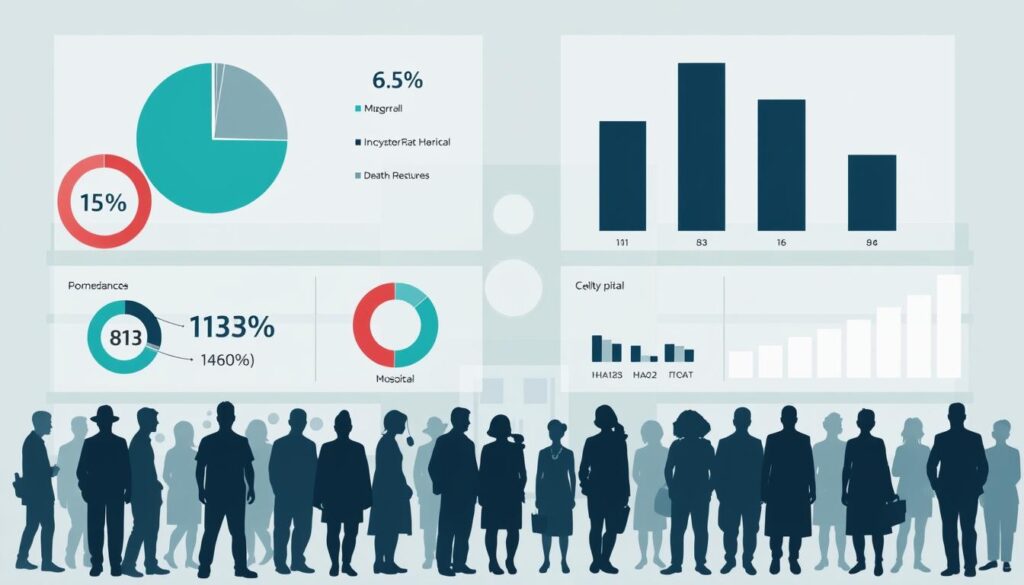Uninsured patients face huge financial burdens due to rising healthcare costs. Luckily, there are ways to manage and reduce medical bills. Let’s explore effective tips to ease the financial strain of medical expenses.
We’ll discuss strategies for negotiating with healthcare providers and lowering bills. You’ll also learn about hospital financial assistance programs and their eligibility criteria. Plus, we’ll cover alternative healthcare options and medical debt relief strategies.
Key Takeaways
- Understand the financial challenges faced by uninsured patients in the United States
- Learn how to negotiate with healthcare providers to lower medical bills
- Discover hospital financial assistance programs and eligibility criteria
- Explore alternative healthcare options and medical debt relief strategies
- Utilize healthcare advocacy groups and payment plan resources
Understanding the Burden of Medical Bills for the Uninsured
The U.S. healthcare system creates huge money troubles for those without insurance. Medical care costs are sky-high. Many uninsured folks and families face crushing medical bills.
Staggering Healthcare Costs in the United States
U.S. healthcare costs are among the world’s highest. The Commonwealth Fund says yearly healthcare spending per person is $10,966. That’s almost double other rich countries’ average.
For the uninsured, this is a big problem. They often must pay full price for medical care. This can be a huge financial hit.
Financial Challenges for Families Without Insurance
Healthcare costs can wreck uninsured families’ finances. A Kaiser Family Foundation study found half of uninsured adults struggle with medical bills. Many risk bankruptcy due to overwhelming medical debt.
This money strain leads to tough choices. Some skip needed medical care. Others turn to crowdfunding to cover their costs.
| Statistic | Value |
|---|---|
| Percentage of uninsured adults reporting difficulty paying medical bills | 46% |
| Average annual healthcare spending per person in the US | $10,966 |
| Percentage of US population without health insurance | 8.5% |
These numbers show the big money problems uninsured Americans face. We must tackle these barriers to affordable healthcare. It’s key to improving life for people across the country.

Negotiating Medical Bills with Healthcare Providers
Dealing with medical bills as an uninsured patient can be overwhelming. But don’t worry! There are ways to negotiate and reduce your costs. Open communication with healthcare providers is crucial.
Start by reviewing your bills carefully. Look for any errors or unclear charges. If you spot issues, contact the billing department for clarification.
Ask for an itemized bill to identify negotiable areas. You might be able to lower costs for specific procedures, medications, or supplies.
- Gather all relevant medical documentation, including any insurance information, prior to initiating negotiations.
- Politely explain your financial situation and explore options for payment plans or reduced fees. Many healthcare providers are willing to work with uninsured patients to find a solution that works for both parties.
- If the initial negotiation is unsuccessful, don’t hesitate to escalate the issue to a higher authority, such as a hospital administrator or financial assistance coordinator.
Clear communication is vital when negotiating medical bills. Work together with your healthcare providers to find a solution. This approach can ease your financial burden and ensure you get needed care.

“Negotiating medical bills can be a challenging, but necessary, process for uninsured patients. With persistence and effective communication, you can often find a solution that works for both you and your healthcare provider.”
Exploring Hospital Financial Assistance Programs
Hospital financial assistance programs offer hope for uninsured patients with mounting medical bills. These programs help individuals and families who lack health insurance or can’t afford healthcare expenses.
Eligibility Criteria for Financial Aid
Eligibility for hospital financial assistance depends on household income, family size, and assets. Many hospitals use a sliding scale system for financial aid.
Patients with lower incomes often qualify for more substantial assistance. Those with higher incomes may still receive partial discounts or payment plans.
Navigating the Application Process
Applying for hospital financial assistance can be overwhelming. Patients should prepare detailed financial information, including pay stubs and tax returns.
It’s crucial to understand the hospital’s specific policies and application deadlines. Familiarizing yourself with these details can make the process smoother.
| Key Steps to Apply for Hospital Financial Assistance |
|---|
|
Understanding eligibility requirements helps uninsured patients access hospital financial assistance programs. This knowledge can significantly reduce the financial burden of medical bills.

Medical Bill Reduction Tips For Uninsured
Managing high medical expenses without insurance can be tough. But don’t worry! There are ways to cut your medical bills and ease money stress. Let’s look at some handy tips to help you save on healthcare costs.
Negotiating With Healthcare Providers
Talking to healthcare providers can help lower your bills. Many providers offer discounts or payment plans to uninsured patients who are honest about their finances. Don’t hesitate to ask for lower fees or explore better payment options.
Exploring Financial Assistance Programs
Many hospitals have programs to help uninsured patients pay medical bills. These programs have specific rules, so research and apply for any that fit. Be ready to show proof of your financial need.
Utilizing Payment Plan Options
If you can’t get a lower bill, ask about setting up a payment plan. Many providers let uninsured patients pay in monthly installments without extra fees or interest. This can make paying off your medical bills much easier.
Seeking Alternative Healthcare Options
For routine care, look into cheaper healthcare options for uninsured people. Try community health clinics or federally qualified health centers. These often have lower prices for those without insurance.
Telemedicine services can also be a good choice. They often cost less and are easy to use from home.
| Strategy | Description | Potential Benefits |
|---|---|---|
| Negotiating with Healthcare Providers | Directly discussing billing and payment options with healthcare providers | Potential discounts, payment plans, or reduced fees |
| Exploring Financial Assistance Programs | Applying for hospital or organization-based financial aid programs | Eligibility for reduced or waived medical bills |
| Utilizing Payment Plan Options | Setting up manageable monthly installments with healthcare providers | Avoiding additional fees or interest charges |
| Seeking Alternative Healthcare Options | Visiting community health clinics, federally qualified health centers, or using telemedicine services | More affordable care for uninsured individuals |
These tips can help you lower your medical bills if you don’t have insurance. Stay strong and keep looking for ways to save on your healthcare costs. There are always options to make medical care more affordable.

Seeking Help from Healthcare Advocacy Groups
Navigating healthcare without insurance can be overwhelming. Luckily, healthcare advocacy groups offer valuable assistance. These organizations help uninsured individuals access needed medical care and resources.
Resources and Support for Uninsured Patients
Healthcare advocacy groups offer various services to support uninsured patients. These include:
- Guidance on finding affordable healthcare options
- Assistance in understanding and negotiating medical bills
- Connections to financial assistance programs and patient support services
- Advocacy and representation when dealing with healthcare providers and insurance companies
These groups understand the challenges faced by the uninsured. They serve as a crucial resource in navigating the healthcare system.
They also help in securing the medical care patients require.
| Healthcare Advocacy Group | Services Offered | Contact Information |
|---|---|---|
| Patient Advocate Foundation |
| Phone: 1-800-532-5274 Website: www.patientadvocate.org |
| NeedyMeds |
| Phone: 1-800-503-6897 Website: www.needymeds.org |
Uninsured patients can access vital support by contacting healthcare advocacy groups. These organizations provide medical bill assistance and patient support services.
They help overcome financial challenges in seeking healthcare. Reach out to them for guidance and support.
Setting Up Affordable Payment Plans
Uninsured patients can manage hefty medical bills through affordable payment plans. Negotiating flexible options with healthcare providers helps avoid crippling medical debt. This approach allows patients to regain control of their finances.
Proactively communicate with your healthcare providers about your financial situation. Don’t wait for bills to pile up. Reach out early to discuss payment plan options.
- Understand your financial capabilities and propose a monthly payment that aligns with your budget. Be honest and transparent about your limitations.
- Negotiate for interest-free or low-interest payment plans that allow you to gradually pay off the bills over time without accruing additional costs.
- Request flexible due dates that accommodate your paycheck schedule and minimize the impact on your day-to-day expenses.
- Explore the possibility of setting up automatic payments, which can help you stay on track and avoid missed deadlines.
Working closely with healthcare providers helps establish manageable payment plans. This approach allows you to effectively manage your medical debt. It also helps avoid the damaging consequences of unpaid bills.
Communication is key in finding a solution that works for you. Being proactive can make a significant difference in managing your medical expenses.
“Negotiating with healthcare providers and setting up affordable payment plans can be a game-changer for uninsured patients struggling with medical bills.”
Stay persistent and keep an open line of communication with your healthcare providers. With effort and flexibility, you can find a suitable payment plan. This approach helps you avoid the pitfalls of medical debt.
Considering Sliding Scale Fees for Uninsured Patients
Sliding scale fees offer hope for uninsured patients facing high healthcare costs. This pricing approach makes medical services more affordable and accessible. It helps people get care without breaking the bank.
Understanding Sliding Scale Fee Structures
Sliding scale fees are based on a patient’s ability to pay. They consider household income to create a flexible, personalized pricing structure. This model makes healthcare more attainable for the uninsured.
Providers look at household size and annual income to set fees. Lower-income patients may get reduced fees or free services. Those with higher incomes pay modest, yet affordable rates.
This system ensures sliding scale fees for uninsured people match their financial situation. It promotes affordable healthcare options and reduced-cost medical services.
| Household Size | Annual Income | Sliding Scale Fee |
|---|---|---|
| 1 | $0 – $12,880 | $0 |
| 2 | $0 – $17,420 | $10 |
| 3 | $0 – $21,960 | $20 |
| 4 | $0 – $26,500 | $30 |
Uninsured patients can benefit from income-based pricing and understanding sliding scale fee structures. This approach makes healthcare more affordable. It removes financial barriers to accessing needed medical care.
“Sliding scale fees have been a game-changer for me. As an uninsured individual, I was able to receive the treatment I needed at a price I could actually afford. It’s a profound relief to know that healthcare can be accessible, even when you don’t have insurance.”
– Jane Doe, Uninsured Patient
Exploring Alternative Healthcare Options
Uninsured individuals face challenges in accessing affordable medical care. Community health clinics offer free or low-cost services to those without insurance. These clinics cater to the needs of underserved populations.
Telehealth services have become a viable solution for affordable healthcare. Patients can consult with providers remotely at lower costs than in-person visits. These virtual consultations cover various medical concerns, from check-ups to minor illnesses.
Preventive care strategies can help maintain overall health and well-being. Uninsured individuals can explore free or discounted screenings and immunizations. Local healthcare organizations often offer these services along with wellness programs.
By focusing on prevention, people can avoid more expensive medical treatments later on. This approach helps manage health proactively and reduces potential financial burdens.

